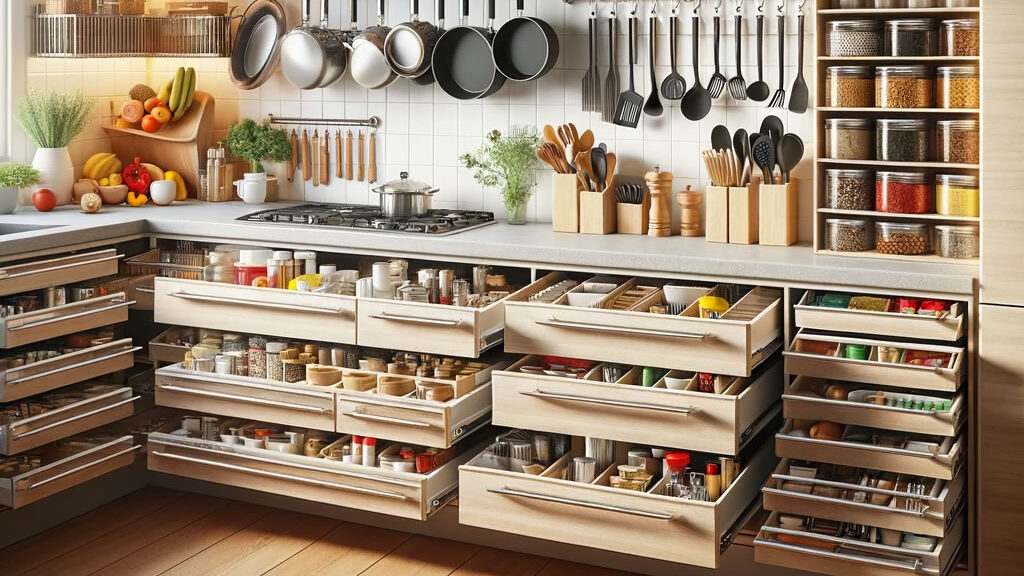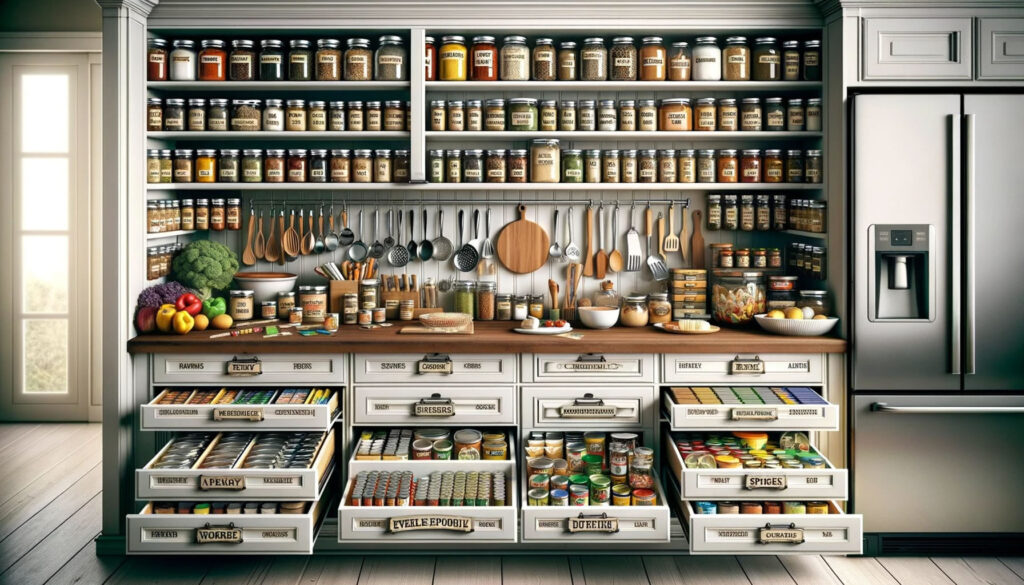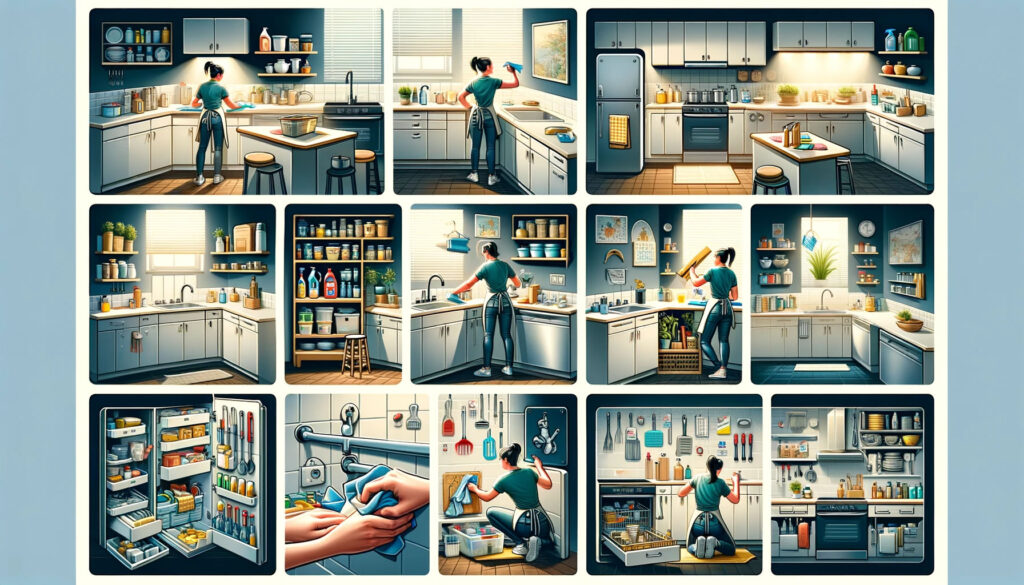In order to maintain a clean and Organizing Your Kitchen, it is essential to keep everything organized and easily accessible.
It can be frustrating to search for ingredients and utensils while cooking a meal, but with the right strategies, you can streamline your kitchen and make meal preparation a breeze.
Whether you have a small kitchen or a large one, these tips and tricks will help you make the most of your space and keep everything in order.
From decluttering and optimizing storage to labeling and creating designated zones, organizing your kitchen has never been easier. Let’s dive into the details!
Table of Contents
Optimize Storage Space

When it comes to organizing your kitchen, one of the most important steps is optimizing your storage space. A well-organized kitchen not only looks clean and tidy, but it also makes meal preparation a breeze.
By maximizing your storage space, you can ensure that everything has its place and is easily accessible.
- Declutter: Before you can optimize your storage space, it’s important to declutter your kitchen. Get rid of any items that are broken, expired, or that you no longer use. This will free up valuable space and make it easier to organize what’s left.
- Utilize vertical space: Take advantage of your kitchen’s vertical space by installing additional shelves or hanging pots, pans, and utensils. This will help free up valuable counter and cabinet space.
- Invest in storage solutions: There are many storage solutions available that can help you maximize your kitchen space. Consider using drawer dividers, shelf organizers, and stackable containers to make the most of your cabinets and drawers.
- Use the inside of cabinet doors: Don’t forget about the inside of your cabinet doors. Install hooks or racks to hang measuring spoons, oven mitts, or even cutting boards. This will free up drawer space and keep frequently used items within reach.
- Group similar items together: Keep your kitchen organized by grouping similar items together. Store all your baking supplies in one area, and keep your spices and oils together. This will make it easier to find what you need and prevent duplicate purchases.
- Utilize unused spaces: Make use of any unused spaces in your kitchen. This could be the space above your cabinets or a small nook that can be converted into a pantry. Get creative and think outside the box.
Optimizing your storage space is key to an organized kitchen.
By decluttering, utilizing vertical space, investing in storage solutions, using the inside of cabinet doors, grouping similar items together, and utilizing unused spaces, you can create a functional and efficient kitchen that makes cooking a pleasure.
Create Designated Zones

Creating designated zones in your kitchen is a key strategy to optimize efficiency and maximize functionality.
By assigning specific areas for different tasks and categories, you can streamline your daily kitchen routines and make everything easily accessible.
Start by analyzing your kitchen layout and considering the different activities that take place in it.
Identify the main functions of your kitchen, such as food preparation, cooking, baking, and cleaning. Then, designate separate zones for each of these activities.
For example, you could create a food preparation zone near your sink and cutting board, with all the necessary tools and ingredients within reach.
In this zone, you can keep knives, utensils, chopping boards, and mixing bowls.
By keeping everything you need in one specific area, you’ll save time and effort when it comes to meal preparation.
In addition to task-specific zones, you can also create zones for different categories of items.
Consider organizing your pantry and cabinets by grouping similar items together. Create zones for spices, canned goods, baking supplies, and snacks.
Label shelves and containers to ensure everything gets placed back in its designated spot.
- Designating zones also extends to your refrigerator. Assign specific areas for dairy products, fruits and vegetables, beverages, and condiments. This eliminates the need to search through a cluttered fridge and prevents items from getting lost or forgotten.
- When it comes to storage, creating designated zones helps you optimize space. Use clear containers or baskets to store items in each zone. This not only keeps everything organized but also allows you to easily see what you have and when it’s time to restock.
- Creating designated zones also encourages others in your household to maintain order. Everyone will know where things belong, making it easier for them to participate in keeping the kitchen organized.
By creating designated zones in your kitchen, you’ll be able to work more efficiently, minimize clutter, and maintain an organized space. With everything in its proper place, meal preparation becomes a breeze and you’ll have more time to enjoy the culinary process.
Label Everything

When it comes to organizing your kitchen, one important step is to label everything. Labeling helps you easily identify where things belong and promotes a sense of order and efficiency in your kitchen.
Firstly, labeling is especially useful for containers and jars. Use clear and concise labels to indicate what’s inside each container. This saves you from the hassle of opening multiple containers to find what you need.
Not only does labeling improve your kitchen organization, but it also enhances safety. Labeling can be particularly helpful if you have any food allergies or dietary restrictions in your household.
By clearly labeling ingredients and separating different types of food, you can prevent cross-contamination and ensure everyone’s well-being.
- Tip: Use waterproof labels to prevent them from smudging or running if they come into contact with water or other liquids in your kitchen.
- Tip: Consider investing in a label maker or use printable labels for a more professional and uniform look.
Secondly, make sure to label your kitchen equipment. Appliances, tools, and utensils often find themselves scattered around the kitchen.
By labeling their designated spots, you can easily navigate and retrieve the tools you need without wasting time searching through drawers and cabinets.
- Tip: Attach labels to the drawers or cabinets where each item belongs. This helps household members who are less familiar with the kitchen locate items easily.
- Tip: To avoid damaging surfaces with adhesive labels, consider using removable labels or sticker tags that can be easily attached and removed as needed.
Last but not least, don’t forget to label your spice rack and pantry. With numerous jars and packets, it can be challenging to locate specific spices and ingredients quickly.
By labeling each spice jar and categorizing your pantry items, you’ll save time searching and create a more streamlined cooking experience.
In conclusion, incorporating labels into your kitchen organization system is a simple yet effective way to maintain order and maximize efficiency.
Whether it’s labeling containers, kitchen equipment, or your spice rack, clear and consistent labeling enhances the functionality and overall aesthetics of your kitchen.
Maintain Regular Maintenance Routine

Maintaining a regular maintenance routine is crucial for keeping your kitchen organized and functioning efficiently. By taking the time to regularly clean and maintain your kitchen, you can prevent clutter and ensure that everything is in its rightful place.
One important aspect of maintaining your kitchen is regular cleaning. Set aside time each week to clean your countertops, appliances, and cabinets. Make sure to use cleaning products that are safe for the surfaces you are cleaning. Wipe down countertops with a gentle cleaner, and use appropriate cleaning solutions for appliances and cabinets.
It’s also important to regularly inspect and repair any damaged or broken items in your kitchen. Check for leaks in your sink or dishwasher and fix them promptly. Replace any broken or malfunctioning appliances or utensils.
By addressing these issues as soon as they arise, you can prevent further damage and ensure that your kitchen remains in good working order.
- Another essential part of kitchen maintenance is organizing and decluttering. Regularly go through your kitchen and remove any items that you no longer use or need.
- Reorganize your storage space periodically to make sure it is functional and meets your needs. Consider investing in storage solutions such as drawer dividers, shelf organizers, and spice racks to maximize efficiency.
- Labeling is a simple yet effective way to keep your kitchen in order. Use labels on drawers, cabinets, and containers to clearly indicate their contents. This not only helps you find what you need quickly but also helps others in your household maintain the organization.
- Finally, establish a routine for meal planning and grocery shopping. By doing so, you can ensure that your kitchen is always stocked with the necessary ingredients and reduce the risk of accumulating unnecessary items.
In conclusion, maintaining a regular maintenance routine is essential for keeping your kitchen organized and functional. By cleaning, repairing, and decluttering regularly, you can create a space that is efficient, visually appealing, and enjoyable to work in.
